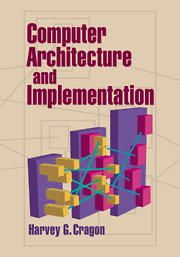2 - PERFORMANCE MODELS AND EVALUATION
Published online by Cambridge University Press: 05 June 2012
Summary
INTRODUCTION
Designers evaluate the performance of computers and the effect of design changes to a computer or subsystem. In general, there are two common techniques for performing these evaluations: simulation and analytic models.
Simulation has a major disadvantage of hiding the effects of workload or architectural parameters that are the input to the simulator. The simulation produces some single measure of performance but the underlying basis for the number is obscure. On the other hand, analytic models must explicitly comprehend each of the workload and architectural parameters. Because of the small time required for obtaining a solution as parameters vary, the effect of these parameters can be evaluated and understood. However, these models do not generally comprehend concurrency and are subject to significant error. Nevertheless, analytic models are used throughout this book for evaluating workloads and architectural parameters because of the insight into design options provided. Note that some of the parameters of an analytic model have been obtained by simulation of a small portion of a system. Memory behavior parameters are examples.
PERFORMANCE MODELS
For a computer or a computer subsystem, what measures of performance can be used by a designer when making design choices? In the domain of computers, we are generally interested in two things: the time to do tasks and the rate at which given tasks are performed.
- Type
- Chapter
- Information
- Computer Architecture and Implementation , pp. 26 - 49Publisher: Cambridge University PressPrint publication year: 2000

